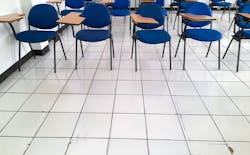Concerns about Covid-19 have heightened people’s awareness of the many materials they encounter as they move through the world and how some substances, often unseen, affect their health.
In school facilities, administrators and maintenance personnel know that the products and materials they choose as they outfit classrooms may create conditions that affect student performance as well as the health and safety of students and staff.
The general trend of education institutions’ becoming more conscientious about their impact on the environment combined with the more urgent call to action in response to the Covid-19 pandemic has made it even more critical for schools and universities to put the health and safety of students and staff at top of mind as they build and finish their facilities.
With regard to flooring, carpeting may be preferred or more suitable in certain areas of a school facility, and resilient floor may be the choice for other sections. But administrators should be aware of the possible hazards that may arise from some flooring and carpeting and look for products materials that are composed of more environmentally friendly materials
“Like many products in our built environment, carpet and flooring products are often made with toxic chemicals that threaten our health and the environment,” the Center for Environmental Health (CEH) says.
To help those making facility decisions about flooring, the Center has offered “10 Reasons to Choose Healthier Carpet and Resilient Flooring.”
The reasons:
- Carpet and flooring can be a significant source of exposure to chemicals that are associated with a range of serious health issues, the CEH says. Health problems linked to chemical exposure are on the rise. Our guidelines restrict the use of harmful substances—including vinyl, PFAS, bisphenols and flame-retardant chemicals—associated with these and other conditions.
- Conventional carpet and flooring products can release volatile organic compounds (VOCs), which have been found to impair cognition. A recent study has found that in a setting with average VOC levels, people had significantly diminished cognitive functions compared with settings with increased ventilation and reduced VOC levels, the CEH says. In the improved indoor environment, participants scored substantially higher on cognition tests that measured functions including crisis response, information usage and strategy, among others.
- Indoor air can be two to five times more polluted than outdoor air, and people in the United States spend an estimated 87% of their time indoors. Crises like COVID-19 and wildfires have forced people to spend more time indoors. Schools should avoid products that can compromise immune systems and exacerbate the health effects of these crises.
- People are demanding safer, healthier, and more sustainable environments, and employers, designers, and building owners are responding. A commitment to healthier products will help education institutions attract and retain students and staff and protect the health and well-being of those who work in school facilities.
- Selecting healthier carpet and resilient flooring products can help a school facility earn sustainability credits for building certification programs.
- Toxic materials in carpet and flooring endanger health across the product life cycle. People involved in the manufacturing, maintenance, and disposal of these products — and those who live in communities where the chemicals are produced and disposed of — are adversely affected, as are air, water, soil, and wildlife.
- The products that meet CEH specifications typically require less maintenance than conventional products. Some of the products used to clean and maintain carpet and flooring can harm the health of cleaning and maintenance workers, and the environment. For example, the resilient flooring products that meet CEH criteria don’t require stripping, sealing, waxing, and finishing needed for conventional resilient floors, thereby saving time and money, and protecting health. Many of the healthier products come in tile or plank formats, so pieces that become damaged can be replaced rather than re-carpeting or flooring the whole area.
- Buying healthier products diverts harmful waste from landfills. In the United States, an estimated 2 million tons of carpet is sent to landfills every year, the CEH, and the toxic chemicals can leach into the soil and groundwater.
- Safer, healthier products that meets our health and safety criteria come in a large range of designs, colors, and formats. Resilient flooring and carpet products that meet our criteria can be found in CEH’s Guide to Selecting Healthier Carpet and Flooring.
- The purchasing power of education institutions can help shift the market toward safer products. “By selecting products with better health and safety profiles, you are joining with other sustainability leaders and are sending a unified message to manufacturers that purchasers don’t want hazardous chemicals in their products,” the CEH says.
About the Author
Mike Kennedy
Senior Editor
Mike Kennedy has been writing about education for American School & University since 1999. He also has reported on schools and other topics for The Chicago Tribune, The Kansas City Star, The Kansas City Times and City News Bureau of Chicago. He is a graduate of Michigan State University.
